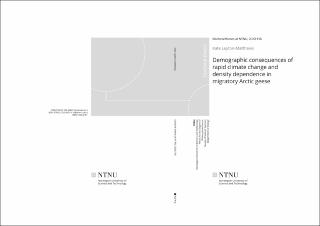| dc.contributor.author | Layton-Matthews, Kate | |
| dc.date.accessioned | 2020-05-07T08:09:08Z | |
| dc.date.available | 2020-05-07T08:09:08Z | |
| dc.date.issued | 2020 | |
| dc.identifier.isbn | 978-82-326-4661-6 | |
| dc.identifier.issn | 1503-8181 | |
| dc.identifier.uri | https://hdl.handle.net/11250/2653574 | |
| dc.description.abstract | Climate change effects are being felt across ecological levels and most strongly in the Arctic. Scaling up from effects on demographic rates to the population-level, and even community-level, is a daunting task. This is particularly the case for migratory species that experience different climate and density regimes over their annual cycle. However, increasingly sophisticated statistical tools provide us with the means to do so. In this thesis, I used state-of-the-art analytical approaches to provide a mechanistic and holistic understanding of the impacts of climate change and density dependence on the population dynamics of a migratory Arctic herbivore, the barnacle goose (Branta leucopsis). The study population of barnacle geese breeds in higharctic Svalbard but spends the winter at Solway Firth, UK, with a spring stopover on mainland Norway. I investigated the dynamics of a local population breeding on western Svalbard, close to the settlement of Ny-Ålesund, using 28 years of individual-based data. In paper I, I used an integrated population model to quantify density dependent effects on vital rates in this population, following their colonisation of new breeding grounds in a period of overall population increase. Local density regulation at the breeding grounds reduced population growth through negative effects on reproduction. This led to density-dependent changes in vital rate contributions to the population growth rate. These results provided empirical evidence that the population dynamics of capital breeders may be more reproduction driven. In paper II, I disentangled climate, density and trophic interaction effects on population dynamics, considering the annual cycle of barnacle geese, i.e., breeding and non-breeding season effects on vital rates. Climate change in Svalbard positively affected egg production and hatching success through rapid advancement of spring onset. However, this was offset by reduced pre-fledging survival due to increasing predation by Arctic foxes, an indirect consequence of climate change linked with changes in abundance of overwintering herbivores. In this way, climate effects on one population can cascade throughout a community. Climate and density also influenced reproduction and survival during the non-breeding season, via carryover effects. Overall, counteracting density, carryover and (direct and indirect) climate effects stabilized breeding population size. In paper III, I analysed variation in an important life-history trait: age at first reproduction (AFR). As established in paper II, advancing spring onset increased the probability of females producing goslings in general, but importantly, this effect was stronger for first-time than experienced breeders. The two week advance in spring phenology led to an earlier AFR, by more than doubling the proportion of two-year-olds reproducing (one year- olds do not reproduce). How the effects of environmental change on such demographic rates are coupled to traits reflecting body condition is important to understand and predict population growth. Body mass is a key fitness related trait for herbivores and fluctuates with resources, which are highly variable in the Arctic. Consequently, coupled trait-demography responses may be important in Arctic herbivores, particularly geese, where body mass has declined in response to habitat degradation. In paper IV, I quantified population-dynamic consequences of changes in body mass in barnacle geese. Despite a 10% decline in body mass, and positive effects of mass on survival and reproduction, this did not translate into trait-mediated effects on population growth. Consequently, the population dynamics of Arctic geese, and possibly other Arctic herbivores, may be more resilient to changing body condition than expected. In this thesis, I highlight the sensitivity, but also resilience, of an Arctic herbivore population to climate change, and other sources of environmental change, and the complex mechanisms by which effects of climate change are translated into changes in population dynamics and abundance. The dynamics of this population were predominantly driven by variation in reproduction, which is the demographic rate most affected by climate change, directly and indirectly. However, mechanisms buffering population dynamics against environmental variation were also evident, such as the lack of demographic effects of declining body condition on the population growth rate. Overall, this work illustrates that a holistic approach, jointly modelling vital rates and the mechanisms for how they influence population dynamics, are necessary to understand effects of e.g. climate change. | en_US |
| dc.language.iso | eng | en_US |
| dc.publisher | NTNU | en_US |
| dc.relation.ispartofseries | Doctoral theses at NTNU;2020:156 | |
| dc.relation.haspart | Paper 1: Layton-Matthews, Kate; Loonen, Maarten J.J.E.; Hansen, Brage Bremset; Coste, Christophe Francois Daniel; Sæther, Bernt-Erik; Grøtan, Vidar. Density‐dependent population dynamics of a high Arctic capital breeder, the barnacle goose. Journal of Animal Ecology 2019 ;Volum 88.(8) s. 1-11
https://doi.org/10.1111/1365-2656.13001| | en_US |
| dc.relation.haspart | Paper 2:
Layton-Matthews, Kate; Hansen, Brage Bremset; Grøtan, Vidar; Fuglei, Eva; Loonen, Maarten J.J.E..
Contrasting consequences of climate change for migratory geese: Predation, density dependence and carryover effects offset benefits of high‐arctic warming. Global Change Biology 2019.
https://doi.org/10.1111/gcb.14773|
This is an open access article under the terms of the Creative Commons Attribution License, (CC BY 4.0) | en_US |
| dc.relation.haspart | Paper 3: Fjelldal, Mari Aas; Layton-Matthews, Kate; Lee, Aline Magdalena; Grøtan, Vidar; Loonen, Maarten J.J.E.; Hansen, Brage Bremset. High-Arctic family planning: earlier spring onset advances age at first reproduction in barnacle geese. Biology Letters 2020 ;Volum 16.(4)
https://doi.org/10.1098/rsbl.2020.0075
This is an open access article under the terms of the Creative Commons Attribution License, (CC BY 4.0) | en_US |
| dc.relation.haspart | Paper 4: Layton-Matthews K, Grøtan V, Hansen BB, Loonen MJJE, Fuglei E, Childs DZ. Environmental change reduces body mass, but not population growth, in an Arctic herbivore. | en_US |
| dc.title | Demographic consequences of rapid climate change and density dependence in migratory Arctic geese | en_US |
| dc.type | Doctoral thesis | en_US |
| dc.subject.nsi | VDP::Mathematics and natural science: 400::Basic biosciences: 470 | en_US |
